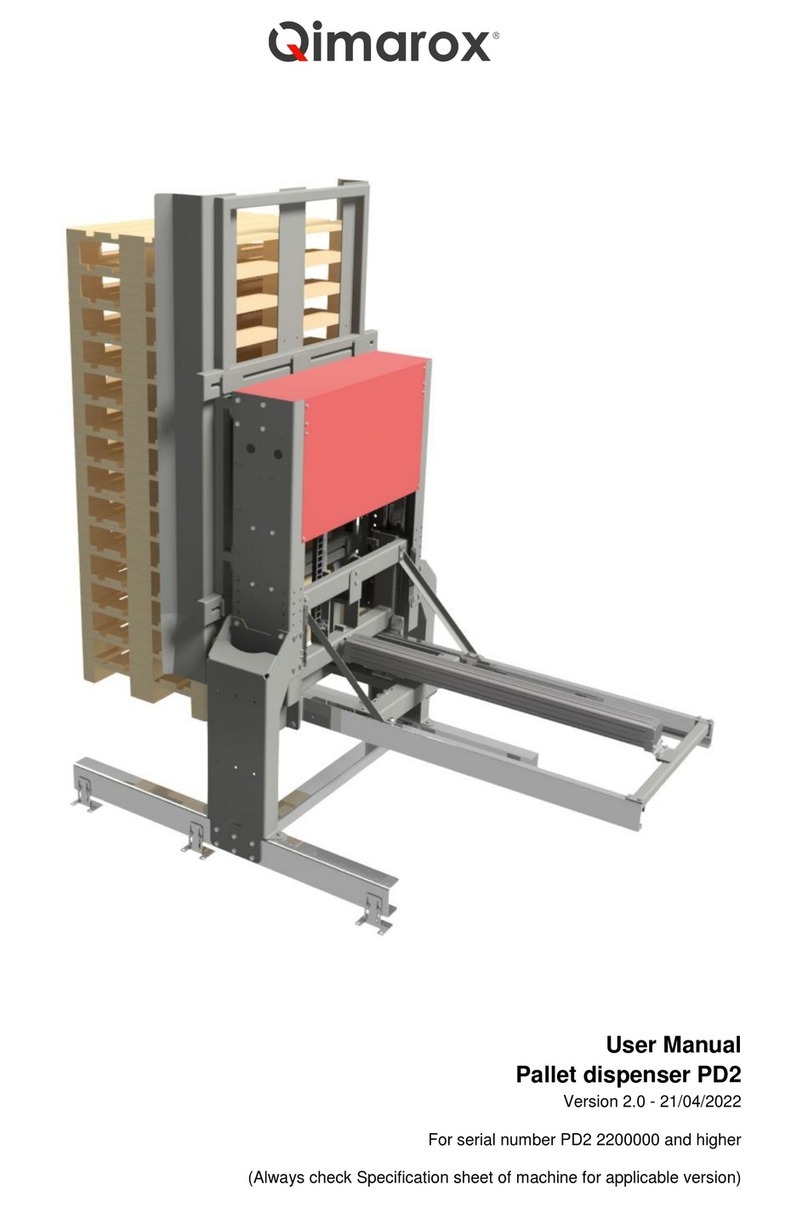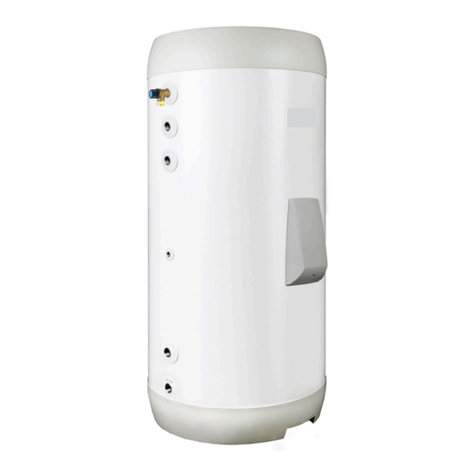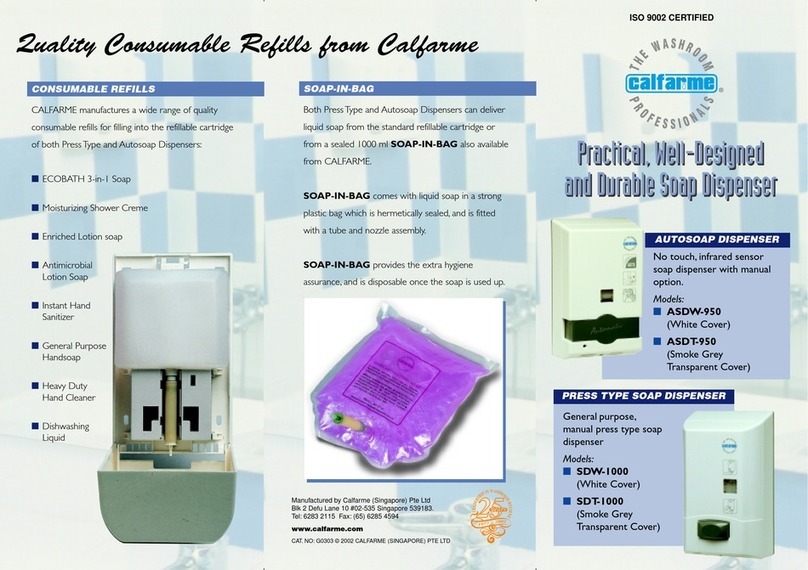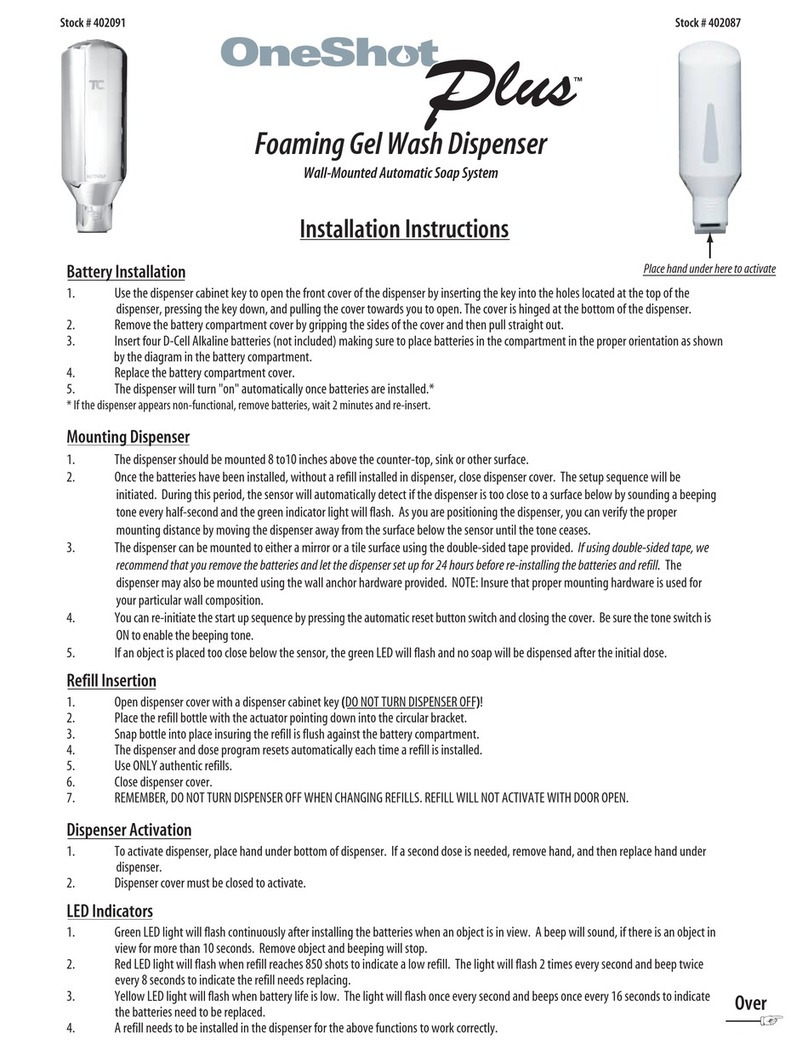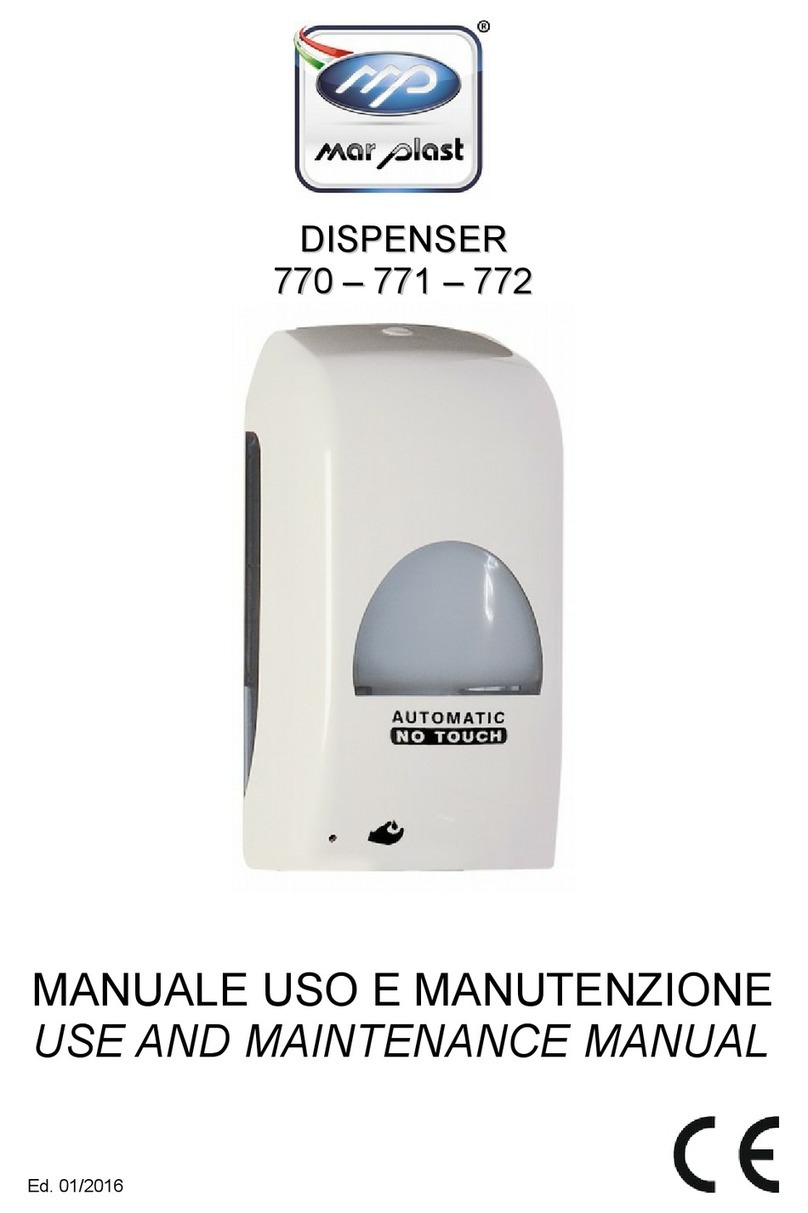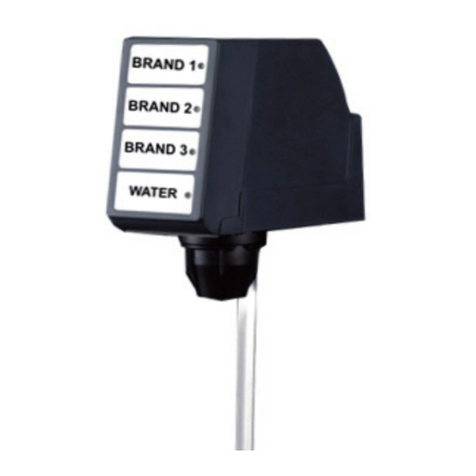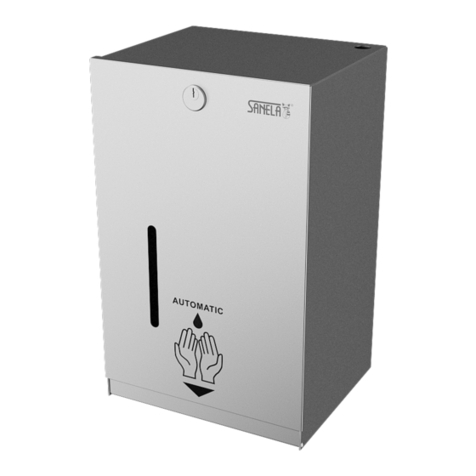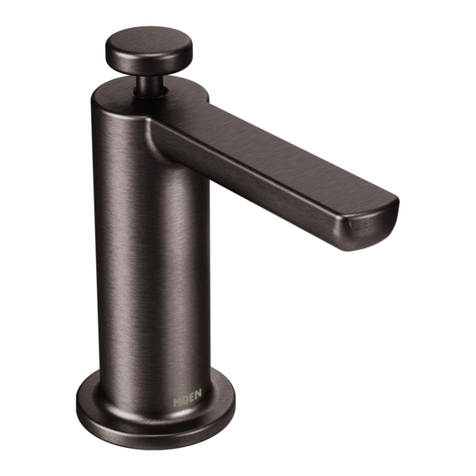Glas Craft Probler User manual

Probler
Dispense Gun
For use with non-ammable foam and polyurea.
Not for use in explosive atmospheres.
90-110 psi (0.62-0.76 MPa, 6.2-7.6 bar) Air Inlet Pressure Range
3000 psi (20.7 MPa, 207 bar) Maximum Static Fluid Pressure
USER MANUAL
Important Safety Instructions
Read all warnings and instructions in
this manual. Save these instructions.

Table Of Contents
Section 1 Installation
Warnings ............................................................................................................................................................ 3
Introduction ........................................................................................................................................................ 7
Standard Equipment .......................................................................................................................................... 8
Equipment Assembly ......................................................................................................................................... 9
Section 2 Operation
Start-up Instructions ........................................................................................................................................... 11
Section 3 General Information
Assembly Drawings ............................................................................................................................................. 14
Maintenance ........................................................................................................................................................ 21
Options and Accessories...................................................................................................................................... 25
Flat Spray Conversion Kits................................................................................................................................... 28
Section 4 Warranty and Reference Information
Limited Time Warranty ........................................................................................................................................ 27
Technical Assistance ........................................................................................................................................... 28
For Your Reference ............................................................................................................................................. 29
2

Warnings
The following warnings are for the setup, use, grounding, maintenance, and repair of this equipment. The exclamation
point symbol alerts you to a general warning and the hazard symbol refers to procedure-specic risk. Refer back to these
warnings. Additional, product-specic warnings may be found throughout the body of this manual where applicable.
3
WARNING
TOXIC FLUID OR FUMES HAZARD
Toxic uids or fumes can cause serious injury or death if splashed in the eyes or on skin, inhaled, or swal-
lowed.
Read MSDS’s to know the specic hazards of the uids you are using.•
Store hazardous uid in approved containers, and dispose of it according to applicable guidelines.• Always wear impervious gloves when spraying or cleaning equipment.•
PERSONAL PROTECTIVE EQUIPMENT
You must wear appropriate protective equipment when operating, servicing, or when in the operating area of
the equipment to help protect you from serious injury, including eye injury, inhalation of toxic fumes, burns,
and hearing loss. This equipment includes but is not limited to:
Protective eyewear•
Clothing and respirator as recommended by the uid and solvent manufacturer• Gloves• Hearing protection•
SKIN INJECTION HAZARD
High-pressure uid from gun, hose leaks, or ruptured components will pierce skin. This may look like just a
cut, but it is a serious injury that can result in amputation. Get immediate surgical treatment.
Do not point gun at anyone or at any part of the body.• Do not put your hand over the spray tip.•
Do not stop or deect leaks with your hand, body, glove, or rag.• Close material shutoff valves and shutoff or disconnect air supply when not spraying.•
Follow Pressure Relief Procedure in this manual, when you stop spraying and before cleaning, checking, • or servicing equipment.
BURN HAZARD
Equipment surfaces and uid that’s heated can become very hot during operation. To avoid severe burns, do
not touch hot uid or equipment. Wait until equipment/uid has cooled completely.
FIRE AND EXPLOSION HAZARD
Flammable fumes, such as solvent and paint fumes, in work area can ignite or explode. To help prevent re
and explosion:
Use equipment only in well ventilated area.• Eliminate all ignition sources; such as pilot lights, cigarettes, portable electric lamps, and plastic drop• cloths (potential static arc).
Keep work area free of debris, including solvent, rags and gasoline.•
Do not plug or unplug power cords, or turn power or light switches on or off when ammable fumes are • present.
Ground all equipment in the work area.• Use only grounded hoses.•
Hold gun rmly to side of grounded pail when triggering into pail.•
If there is static sparking or you feel a shock, stop operation immediately. Do not use equipment until • you identify and correct the problem.
Keep a working re extinguisher in the work area.•

WARNING
EQUIPMENT MISUSE HAZARD
Misuse can cause death or serious injury.
Do not operate the unit when fatigued or under the inuence of drugs or alcohol.•
Do not exceed the maximum working pressure or temperature rating of the lowest rated system compo-• nent. See Technical Data in all equipment manuals.
Use uids and solvents that are compatible with equipment wetted parts. See Technical Data in all •
equipment manuals. Read uid and solvent manufacturer’s warnings. For complete information about
your material, request MSDS forms from distributor or retailer.
Check equipment daily. Repair or replace worn or damaged parts immediately with genuine manufactur-• er’s replacement parts only.
Do not alter or modify equipment.• Use equipment only for its intended purpose. Call your distributor for information.•
Route hoses and cables away from trafc areas, sharp edges, moving parts, and hot surfaces.•
Do not kink or over bend hoses or use hoses to pull equipment.•
Keep children and animals away from work area.• Comply with all applicable safety regulations.•
PRESSURIZED ALUMINUM PARTS HAZARD
Do not use 1,1,1-trichloroethane, methylene chloride, other halogenated hydrocarbon
solvents or uids containing such solvents in pressurized aluminum equipment. Such
use can cause serious chemical reaction and equipment rupture, and result in death,
serious injury, and property damage.
4
Warnings

Isocyanate Hazard
Spraying materials containing isocyanates creates
potentially harmful mists, vapors, and atomized
particulates.
Read material manufacturer’s warnings and
material MSDS to know specic hazards and
precautions related to isocyanates.
Prevent inhalation of isocyanate mists, vapors, and
atomized particulates by providing sufcient ventila-
tion in the work area. If sufcient ventilation is not
available, a supplied-air respirator is required for
everyone in the work area.
To prevent contact with isocyanates, appropriate
personal protective equipment, including chemically
impermeable gloves, boots, aprons, and goggles, is
also required for everyone in the work area.
Material Self-Ignition
Some materials may become self-igniting if applied
too thickly. Read material manufacturer’s warnings
and material MSDS.
Moisture Sensitivity of
Isocyanates
Isocyanates (ISO) are catalysts used in two component
foam and polyurea coatings. ISO will react with moisture
(such as humidity) to form small, hard, abrasive crystals,
which become suspended in the uid. Eventually a lm will
form on the surface and the ISO will begin to gel, increas-
ing in viscosity. If used, this partially cured ISO will reduce
performance and the life of all wetted parts.
The amount of lm formation and rate of crystal-
lization varies depending on the blend of ISO,
the humidity, and the temperature.
To prevent exposing ISO to moisture:
Always use a sealed container with a desiccant dryer• in the vent, or a nitrogen atmosphere. Never store ISO
in an open container.
Keep the ISO lube pump reservoir lled with Graco • Throat Seal Liquid (TSL), Part 206995. The lubricant
creates a barrier between the ISO and the atmosphere.
Use moisture-proof hoses specically designed for • ISO, such as those supplied with your system.
Never use reclaimed solvents, which may contain•
moisture. Always keep solvent containers closed when
not in use.
Never use solvent on one side if it has been contami-• nated from the other side.
Always park pumps when you shutdown.•
Always lubricate threaded parts with Part 217374 ISO• pump oil or grease when reassembling.
5
Warnings

Keep Components A and B
Separate
CAUTION
To prevent cross-contamination of the equipment’s wet-
ted parts, never interchange component A (isocyanate)
and component B (resin) parts. The gun is shipped with
the A side on the left. The uid manifold, uid hous-
ing, side seal assembly, check valve cartridge, and mix
chamber are marked on the A side.
Foam Resins with 245 fa
Blowing Agents
New foam blowing agents will froth at temperatures above
90°F (33 °C) when not under pressure, especially if agitat-
ed. To reduce frothing, minimize preheating in a circulation
system.
Changing Materials
When changing materials, ush the equipment mul-• tiple times to ensure it is thoroughly clean.
Always clean the uid inlet strainers after ushing.•
Check with your material manufacturer for chemical • compatibility.
Most materials use ISO on the A side, but some use• ISO on the B side.
Epoxies often have amines on the B (hardener) side.• Polyureas often have amines on the B (resin) side.
6
Warnings

7
Section 1 - Installation: Introduction
Introduction
Before operating, maintaining or servicing any
GlasCraft system, read and understand all of the
technical and safety literature provided with GlasCraft
products. If you do not have the proper or related
manuals and safety literature for your GlasCraft system,
contact your GlasCraft distributor.
In this GlasCraft technical and safety publication, the
following advisories will be provided where appropriate:
Information about the procedure in progress.
Indicates a hazardous situation that can result in death
or serious injury.
The information in this document is intended only to
indicate the components and their normal working
relationship typical use. Each assembly should be
directed by a GlasCraft distributor or made from the
GlasCraft Assembly instructions provided.
This manual provides information for the assembly, opera-
tion, maintenance and service of this GlasCraft product as
used in a typical conguration. While it lists standard speci-
cations and procedures, some deviations may be found.
In order to provide our users with the most up-to-date
technology possible, we are constantly seeking to improve
products. If a technological change occurs after a prod-
uct is on the market, we will implement that technology in
future production and, if practical, make it available to cur-
rent users as a retrot, update or supplement. If you nd
a discrepancy between your unit and the available docu-
mentation, contact your GlasCraft distributor to resolve the
difference.
Careful study and continued use of this manual will pro-
vide a better understanding of the equipment and process,
resulting in more efcient operation, longer trouble-free
service and faster, easier troubleshooting.
WARNING
7

8
Standard Equipment
Part
Number Description
GCP1RX Flat Probler Dispense Gun
GCP1FX Round Probler Dispense Gun
313265 User Manual
Section 1 - Installation: Standard Equipment

9
Section 1 - Installation: Equipment Assembly
How The Gun Works
The Probler Gun is used to spray or pour two-
component, low viscosity polyurethane foam materials
at outputs up to 60 pounds per minute. The gun
features an air-assited full-nger trigger and a
patented solvent-free automatic air-purge cleaning
system.
The trigger actuates a small valve in the gun handle
that controls the ow of air into the piston assembly.
When the trigger is pulled, air ows through the valve to
the front of the piston. Air pressure forces the piston to-
wards the rear of the gun, simultaneously closing off
the purge air and moving the mixing chamber to a
position where the mixing chamber orices are aligned
with the orices in both the side block seal and
check valve assemblies.
The proper alignment of the orices is determined by
the setting of the Set Screw, p/n GC0143, located
at the rear of the piston assembly. This set screw
determines the length of travel of the air piston and
has been preset at the factory and should not require
adjustment. (SEE MAINTENANCE SECTION)
The two uids (isocyanate and polyol) then ow through
the material shut-off valves, seal, and check valve
assemblies and into the mixing chamber. The two
uids impinge against one another and exit the mixing
chamber in a swirling, conical spray pattern.
When the trigger is released, the mixing chamber
returns to its original position and purge air ows into
the mixing chamber housing. The front
tip o-ring, keeps air purge inside the gun
head, forcing all of the air through the
orices in the mixing chamber, for a complete, total and
constant purge.
This purge air continues to ow through the mixing
chamber until the air switch, is pulled up to shut-off all
air to the gun; or until the trigger is pulled again.
GlasCraft Equipment
Air Hose is ¼ in. NPS
JIC and SAE Fittings DO NOT require the use of PTFE
tape.
Once the ttings are attached and tight, refer to sys-
tem manuals for start-up instructions.
*Fitting GC2394 is an unattached part that may need to
be connected to the air hose rst, then connected to the
gun, depending on air hose tting.
ISO
*AIR
POLY

10
Section 1 - Installation: Equipment Assembly
Assembly Instructions
Refer to specic system user manual for complete
system installation.
See GCP1RX Gun illustration during instructions.
1. Connect whip hose to gun assembly. The swivel
ttings on the whip hose assembly are sized differ-
ently and will attach only one way. (Match like sized
ttings.) Also connect the air hose assembly to the
gun at this time.
2. Fluid hose connections between console and gun
should now be complete. Ensure all hose and gun
ttings are tight before proceeding:
AIR
POLYOL
ISOCYANATE
WHIP HOSE

11
Section 2 - Operation: Start-Up Instructions
WARNING
WARNING
WARNING
WARNING
Refer to specic system user manuals for complete
system installation.
Pre operation Checklist
Check that all ttings are tight and air regulators are
turned to “zero pressure”.
Do not place any part of the body in the path of the
material spray.
Do not point the gun at or near other personnel.
Do not look into the mixing chamber orice at any time.
Because of the hazardous materials used in this
equipment, it is recommended that the operator use an
air mask, goggles, protective clothing, and other safety
equipment as prescribed by current regulations, recom-
mendations of the chemical suppliers, and the laws in
the area where the equipment is being used.
Operating Requirements
• 8-10 CFM at 90-110 psi (0.62-0.76 MPa,
6.2-7.6 bar)
• MAXIMUM Static Fluid Pressure - 3000 psi (20.7
MPa, 207 bar)
The GlasCraft Probler Gun is designed and manufac-
tured to operate at a maximum static uid pressure not
to exceed 3000 psi (20.7 MPa, 207 bar). When attached
to a GlasCraft proportioning system, this pressure will
not be exceeded. However, if the GlasCraft Probler Gun
is installed on any other manufacturer’s self-designed
equipment, great care must be taken to ensure that the
maximum static uid pressure not be exceeded.
If the gun is being used for short periods of spraying,
GlasCraft recommends that the purge air be left ON.
If purge air is to be turned OFF, BOTH MATERIAL SHUT-
OFF VALVES, MUST BE TURNED TO THEIR “OFF” POSI-
TION BEFORE TURNING “OFF” THE PURGE AIR !
Failure to follow this procedure will possibly result in the gun
head becoming encased with mixed product.
For proper purging following use, the air switch must be left
OPEN for at least 15 SECONDS after the trigger has been
released.
The ow of material into the mixing chamber is controlled by
the ON or OFF position of the two material shut-off valves.
Both material shut-off valves must be FULLY OPEN
during dispensing and must be FULLY CLOSED during
service or extended shut-down periods.
BEFORE REMOVING SIDEBLOCK SCREWS, BOTH MA-
TERIAL SHUT-OFF VALVES MUST BE TURNED TO THEIR
“OFF” POSITION. TRIGGER GUN SEVERAL TIMES TO
DEPRESSURIZE GUN .
Failure to follow this procedure will possibly result in the gun
head becoming encased with mixed product.
ON OFF
Refer to system manuals for start-up and
shut-down procedures.

12
Section 2 - Operation: Start-Up Instructions
Initial Start-Up Procedure
With all material and air lines connected, the gun is now
ready for start-up.
1. Remove the side blocks on the front housing of the
gun, by removing screws.
2. Place separate clean containers under each
individual side block. Open manual material
valves (black arrow forward, see Fig. 4 and Fig. 5)
on each side block simultaneously to allow trapped
air to escape the hose and material to ow into the
containers until all air is purged from the material
system. (See Fig. 3)
3. Close manual material valves simultaneously.
Material pressure gauges on each Heater should
now register approximately equal pressure. If one
side registers considerably more pressure than the
other side, go to the high pressure side and bleed
off some pressure by slightly opening the manual
material valve on the side block over the container.
Bleed pressure until both sides are approximately
the same pressure.
4. Dispose of waste material properly and in accord-
ance with chemical suppliers, instructions and local,
state and federal regulations.
Before re-assembling side blocks, lubrication can
be applied by dabbing a white lithium grease into
holes inside of gun front housing and wiping grease
over side block seals. Grease will purge itself when
air valve is turned on at gun and gun is triggered.
5. Clean and lubricate side blocks and seals thoroughly
and reassemble onto gun. Make certain that side
block screws are tightened securely.
6. Turn purge air and material valves on at gun.
(See Fig. 4 and Fig. 5).
Remember to dispense one to two gallons of mat-
erial to clear the system of grease and plasticizer
that was used during factory testing.
The Polyol will expand in the hose if any normal ope-
rating pressures are bled off whenever the material is
above approximately 75 degrees F. Hot polyol hoses
should never be bled, by any method, to zero pressure
for two reasons.
1. The seals in the gun rely on high pressure to make
their seal. The high pressure cannot be maintained
if the pumps are attempting to apply this pressure
through a hose full of expanded froth; therefore, the
gun seal may leak.
2. Re-starting immediately after hot polyol has expand-
ed in the system may result in spraying substantial
amounts of “bad” foam. This will continue until the
expanded polyol in the primary heater and the hose
has been completely purged.
Fig. 3 Fig. 4 Fig. 5
WARNING

13
Section 2 - Operation: Start-Up Instructions
Spray Technique
Always operate safely and follow all safety procedures
outlined.
To achieve the optimum spray pattern for each applica-
tion, several mixing chambers are available.
The standard mixing chamber supplied with your gun
will be adequate for all but the smallest and largest
applications.
Foam rise and cure times will vary according to the
material and substrate temperature. Higher material or
substrate temperature will increase rise and cure times;
lower material or substrate temperatures will decrease
rise and cure times. Consult your chemical manufac-
turer’s data specication sheets for their recommended
spray temperatures. Under most circumstances, both
components will be used at identical temperatures.
Higher pressures and temperatures may be used to
increase material break-up, improve mixing and speed
rise times. With hose lengths over 50 ft., or when mater-
ial viscosities are high, higher material pump pressures
may be necessary.
The gun air switch assembly MUST BE OPENED
(down position) prior to spraying to provide air for trigger
operation and purge air when the trigger is released.
When spraying, the gun trigger may be depressed con-
tinuously, or triggered at the end of each stroke. A smooth,
even layer is best achieved by moving the gun back and
forth in a slow, even motion, overlapping the previous pass
about 50 to 75 percent. DO NOT SPRAY OVER RISING
FOAM! The ideal gun-to-surface distance is about 18 to 24
inches. Be sure to point the gun directly at the surface to be
sprayed. Spraying at an angle to the surface will cause the
foam to be rough and will generate overspray.

Section 3 - Parts and Illustrations:
Gun Handle Air Passage Locations and Thread Sizes
14
1/4 DRILL
1/8 DRILL
3/32 DRILL
19/64 DRILL
NOTE: All fractional dimensions recorded in inches
3/4-16 UNF-2B (TAP)
1 -5/8-20 UN-2B (TAP)
N DRILL
1/4-20 UNC-2B (TAP)
#29 DRILL
8-32 UNC-2B (TAP)
#29 DRILL
10-32 UNF-2B (TAP)
#29 DRILL
10-32 UNF-2B (TAP)
#29 DRILL
10-32 UNF-2B (TAP)
1/8 DRILL
8/32 UNC-2B (TAP)
#29 DRILL

Section 3 - Parts and Illustrations: GCP1RX Round Probler Dispense Gun
26
8
9
Mixing Chamber Assembly
(see chart)
34
36
5
41
25
22
17c
15b
15d 15e
15f
15a
15c17d
17b
17a
(17) Air Switch Assembly (15) Piston Assembly
33
32
31
47
30
44
19
6
20
24
21
27
17
15
32
29
15
Round Spray
Probler Gun 8 9 13 26 Service Kit
GCP1R0 GC0114 GC2528 GC2540 GC2530 GC0166
GCP1R1 GC0114 GC2528 GC2540 GC2531 GC0167
GCP1R2 GC0114 GC2528 GC2540 GC2532 GC0167
GCP1R3 GC0114 GC2528 GC2540 GC2533 GC0167
GCP1R4 GC0115 GC2529 GC2541 GC2534 GC0168
GCP1R5 GC0115 GC2529 GC2541 GC2535 GC0168

Section 3 - Parts and Illustrations: GCP1RX Round Probler Dispense Gun
1
40
35
45
11
12
10
16
5
22
14
13
46
39
5
37
38
22
18
43
23
2
Complete Filter
Assembly
available, GC0123
4
29
3
7
Complete Seal & Valve Kit
available, GC0145
(00-03 only)
16

17
Section 3 - General Information: GCP1RX Round Probler Dispense Gun Parts
List
Ref.
No. Part
No. Description Qty.
1 117634 SWIVEL, UNION, NO #6 JIC 1
2 117635 SWIVEL, UNION 1
3 GC0061 RETAINER, RING 1
4 GC0101 SUPPORT, STRAINER 1
5 GC0102 HOUSING, CHAMBER, MIXING 1
6 GC0110 CAP, REAR, PROBLER, HG 1
7 GC2547 STRAINER, PROBLER H.G 1
8 CAP, AIR, PROBLER; see matrix
table on parts illustration 1
9 SEAL, CHAMBER, MIXING; see
matrix table on parts illustration 1
10 GC2544 VALVE, BALL, CHECK,ASSY 2
11 GC2546 SPRING, COMPRESSION, .180 OD 2
12 GC2545 HOUSING, VALVE, CHECK 2
13 SEAL, VALVE, MIXING, HARD; see
matrix table on parts illustration 2
14 GC2542 RETAINER, SEAL, VALVE, CHECK 2
15 GC0122 GUN, ASSY, PISTON, H.G.PRO 1
15a GC0111 PISTON, H.G. PROBLER 1
15b GC0112 SHAFT, PISTON 1
15c GC0125 RING, RETAINING, 5/16 2
15d 168518 PACKING, O-RING 1
15e C20988 PACKING, O-RING 2
15f C20207 PACKING, O-RING 1
16 GC2543 SPRING, COMPRESSION, .300 OD 2
17 GC0128 SWITCH, ASSY, SWITCH, AIR 1
17a 110242 O-RING 1
17b 106555 O-RING 2
17c GC0126 AIR SWITCH TUBE 1
17d GC0127 AIR SWITCH SPOOL 1
18 GC0129 GUARD, TRIGGER, PROBLER 1
19 GC0130 PLUG, PLUG, VALVE, TRIGGER 1
20 GC0131 SCREW, BHDC,AS, .375-24X
.500ZP 1
21 GC0132 SPRING, COMPRESSION .845 1
22 GC0134 HANDLE, PROBLER 1
23 GC0142 SCREW, BHDC, SS, 0.190-24X
.500 2
24 GC0143 SCREW, SET, FLPT, 3/8 THD X 1/2 1
25 GC0144 SCREW, SET, FUDG, 0.138 X 1/4
in. L 1
26 MODULE, CHAMBR, MIXN,
0.035/.037; see matrix table on parts
illustration
1
27 GC0331 FITTING, PLUG 1
Ref.
No. Part
No. Description Qty.
28 GC2394 FITTING, FTG, ADAPTER, SWIVEL,
1/4NPT X 1/4 in. NPSM
1
29 115719 PACKING, O-RING, 015,VITON 2
30 110241 PACKING, O-RING 3
31 GC2079 SCREW, SET, HALF DOG, #8 1
32 GC2082 SCREW, SET, FLPT, #8, 1/4, SST 2
33 GC2087 SCREW, RDHD, CS, 0.190-32X
0.250 ZP 2
34 GC2149 SCREW, SHDC, SS, 0.250-20X
0.750 1
35 GC2196 FITTING, PIPE, NIPPLE, HEX,
1/8X1/8 NPT
2
36 GC2230 SCREW, SET, FTPT, 0.138-32X
0.625 1
37 GC2237 SCREW, SHOULDER, 1/4X10-24
STL 1
38 GC2250 SCREW, SHDC, AS, 0.250-20X
0.875ZP 1
39 GC2253 SCREW, SHDC,AS, 0.250-20-
X1.500ZP 2
40 GC2337 VALVE, BALL, 2-WAY,1/8 NPTF;
SST 2
41 GC2338 BUTTON, TRIGGER 1
42 GC2339 BRACKET, SUPPORT, TRIGGER 1
43 GC2340 TRIGGER 1
44 GC2341 SPRING, COMPRESSION, 0.240
OD 1
45 GC2380 BLOCK, SIDE, POLYOL 1
46 GC2549 BLOCK, SIDE, ISO 1
47 GC2390 TRIGGER 1

Section 3 - Parts and Illustrations: GCP1FX Flat Probler Dispense Gun
18
15c
13b
13d
27
24
37
30
45
23
34
33
32 31
51
48
17
18
6
22
19
15 13
28
33
20
5
35
25
42
43
26
13e
13f
13a
13c
15d
15b
15a
(15) Air Switch Assembly
(13) Piston Assembly
Flat Spray
Probler Gun 11 24 42 Service
Kit
GCP1F0 GC2540 GC2550 GC2332 GC0166
GCP1F1 GC2540 GC2551 GC2332 GC0167
GCP1F2 GC2540 GC2552 GC2332 GC0167
GCP1F3 GC2540 GC2553 GC2332 GC0167
GCP1F4 GC2541 GC2554 GC2333 GC0168
GCP1F5 GC2541 GC2555 GC2333 GC0168

Section 3 - Parts and Illustrations: GCP1FX P2 Dispense Gun
19
12
49
20
5
46
38
16
47
21
39
1
44
36
9
10
8
14
520 50
2
4
30
3
7
40
11
Complete Filter Assembly
available, GC0123
Complete Seal & Valve Kit
available, GC0145
(00-03 only)

20
Section 3 - General Information: GCP1FX Flat Probler Dispense Gun Parts List
Ref.
No. Part
No. Description Qty.
1 117634 SWIVEL, UNION, NO #6 JIC 1
2 117635 SWIVEL, UNION 1
3 GC0061 RETAINER, RING 1
4 GC0101 SUPPORT, STRAINER 1
5 GC0102 HOUSING, CHAMBER, MIXING 1
6 GC0110 CAP, REAR, PROBLER 1
7 GC2547 STRAINER, PROBLER 1
8 GC2544 VALVE, BALL, CHECK, ASSY 2
9 GC2546 SPRING, COMPRESSION, 0.180 OD 2
10 GC2545 HOUSING, VALVE, CHECK 2
11 SEAL, VALVE, MIXING; see matrix on
parts illustration 2
12 GC2542 RETAINER, SEAL, VALVE, CHECK 2
13 GC0122 GUN, ASSY, PISTON 1
13a GC0111 PISTON, H.G. PROBLER 1
13b GC0112 SHAFT, PISTON 1
13c GC0125 RING, RETAINING, 5/16 2
13d 168518 PACKING, O-RING 1
13e C20988 PACKING, O-RING 2
13f C20207 PACKING, O-RING 1
14 GC2543 SPRING, COMPRESSION, 0.300 OD 2
15 GC0128 SWITCH, ASSY, SWITCH, AIR 1
15a 110242 O-RING 1
15b 106555 O-RING 2
15c GC0126 AIR SWITCH TUBE 1
15d GC0127 AIR SWITCH SPOOL 1
16 GC0129 GUARD, TRIGGER 1
17 GC0130 PLUG, PLUG, VALVE, TRIGGER 1
18 GC0131 SCREW, BHDC, AS, 0.375-24X .500ZP 1
19 GC0132 SPRING, COMPRESSION .845 1
20 GC0134 HANDLE 1
21 GC0142 SCREW, BHDC, SS, 0.190-24X .500 2
22 GC0143 SCREW, SET, FLPT, 3/8 THD X 1/2 1
23 GC0144 SCREW, SET, FUDG, 0.138 X 1/4 in.L 1
24 MODULE, CHAMBER, MIXING; see
matrix on parts illustration 1
25 GC0256 CAP, AIR, FLAT, SPRAY 1
26 GC0257 NUT, NOZZLE, CAD.FL. 1
27 GC0258 SEAL, CAP, AIR 1
28 GC0331 FITTING, PLUG 1
Ref.
No. Part
No. Description Qty.
29 GC2394 FITTING, FTG, ADAPTER, SWIVEL,
1/4 in. NPT X 1/4 in. NPSM
1
30 115719 PACKING, O-RING, 015, VITON 2
31 110241 PACKING, O-RING 3
32 GC2079 SCREW, SET, HALF DOG, #8 1
33 GC2082 SCREW, SET, FLPT, #8, 1/4, SST 2
34 GC2087 SCREW, RDHD, CS, 0.190-32X .250
ZP 2
35 GC2149 SCREW, SHDC, SS, 0.250-20X .750 1
36 GC2196 FITTING, PIPE, NIPPLE, HEX, 1/8 X
1/8 NPT
2
37 GC2230 SCREW, SET, FTPT, 0.138-32 X 0.625 1
38 GC2237 SCREW, SHOULDER, 1/4 X 10-24 STL 1
39 GC2250 SCREW, SHDC,AS, 0.250-20 X
.875ZP 1
40 GC2253 SCREW, SHDC,AS, 0.250-20
X1.500ZP 2
42 CONNECTOR; see matrix on parts
illustration 1
43 GC2335 SEAL, NOZZLE, FLUID 1
44 GC2337 VALVE, BALL, 2-WAY, 1/8 NPTF SST 2
45 GC2338 BUTTON, TRIGGER 1
46 GC2339 BRACKET, SUPPORT, TRIGGER 1
47 GC2340 TRIGGER, PROBLER 1
48 GC2341 SPRING, COMPRESSION, 0.240 OD 1
49 GC2380 BLOCK, SIDE, POLYOL 1
50 GC2549 BLOCK, SIDE, ISO 1
51 GC2390 TRIGGER 1
Table of contents
Other Glas Craft Dispenser manuals

Glas Craft
Glas Craft Guardian A5-6000 IP User manual
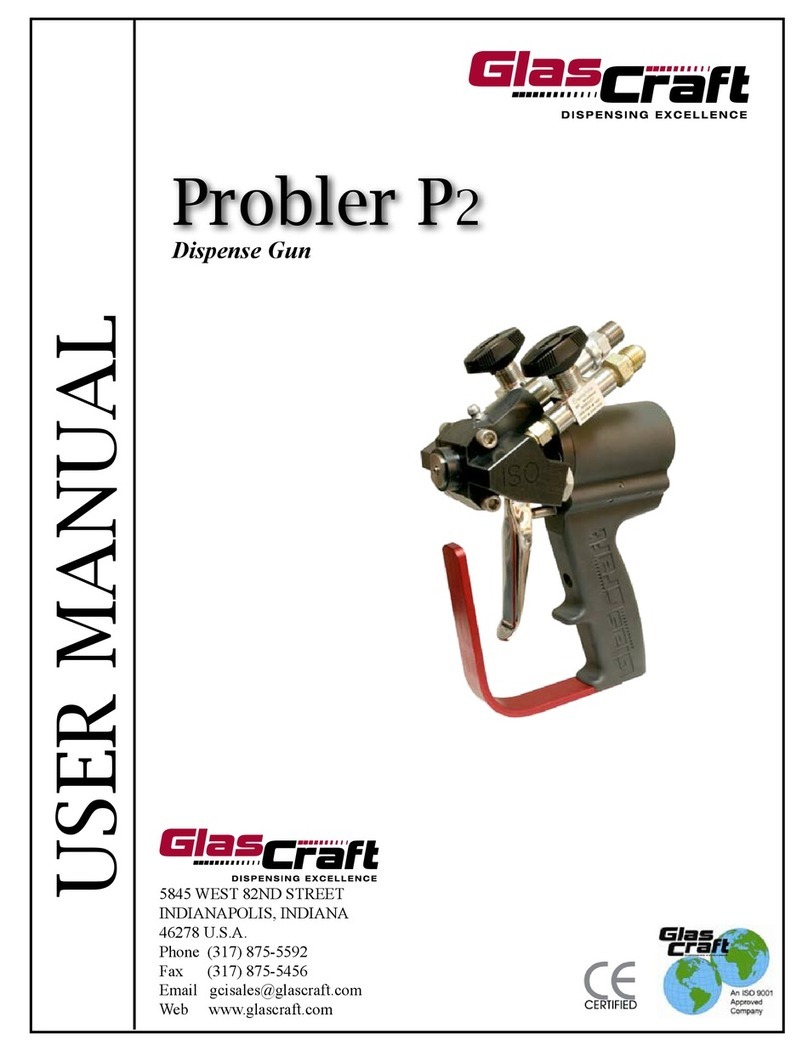
Glas Craft
Glas Craft Probler P2 User manual

Glas Craft
Glas Craft GUARDIAN A5-3000 IP User manual
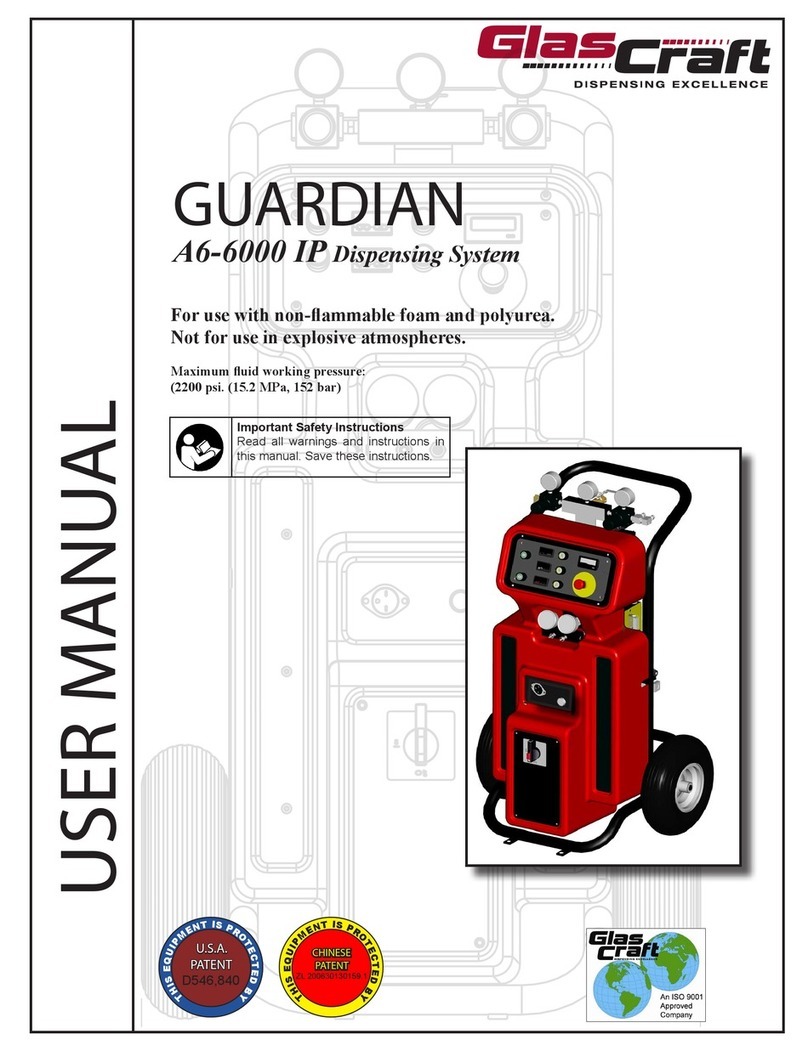
Glas Craft
Glas Craft Guardian A6-6000 IP User manual
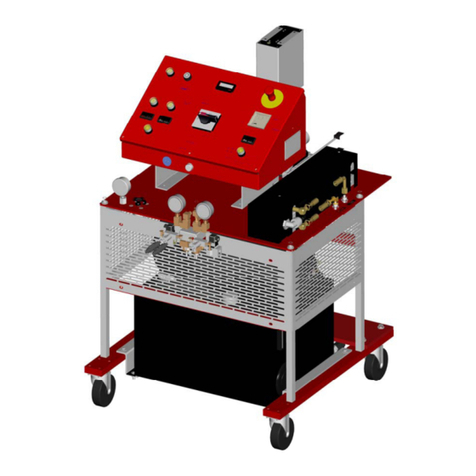
Glas Craft
Glas Craft MH II User manual
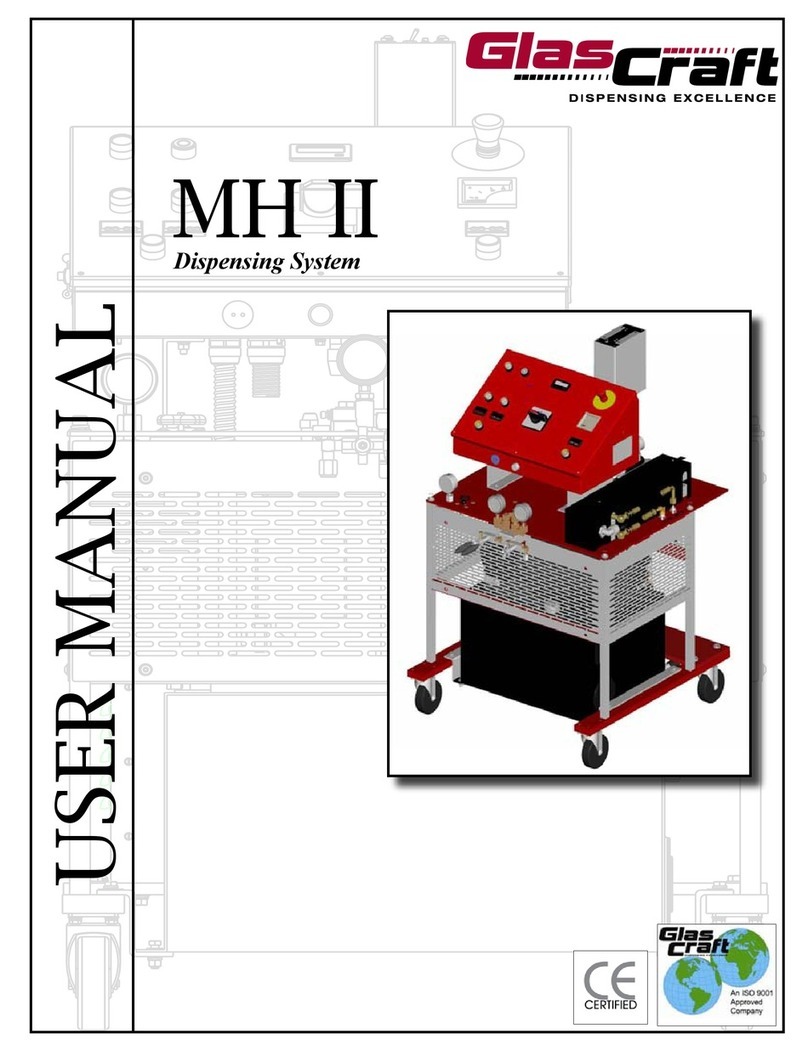
Glas Craft
Glas Craft MH II User manual
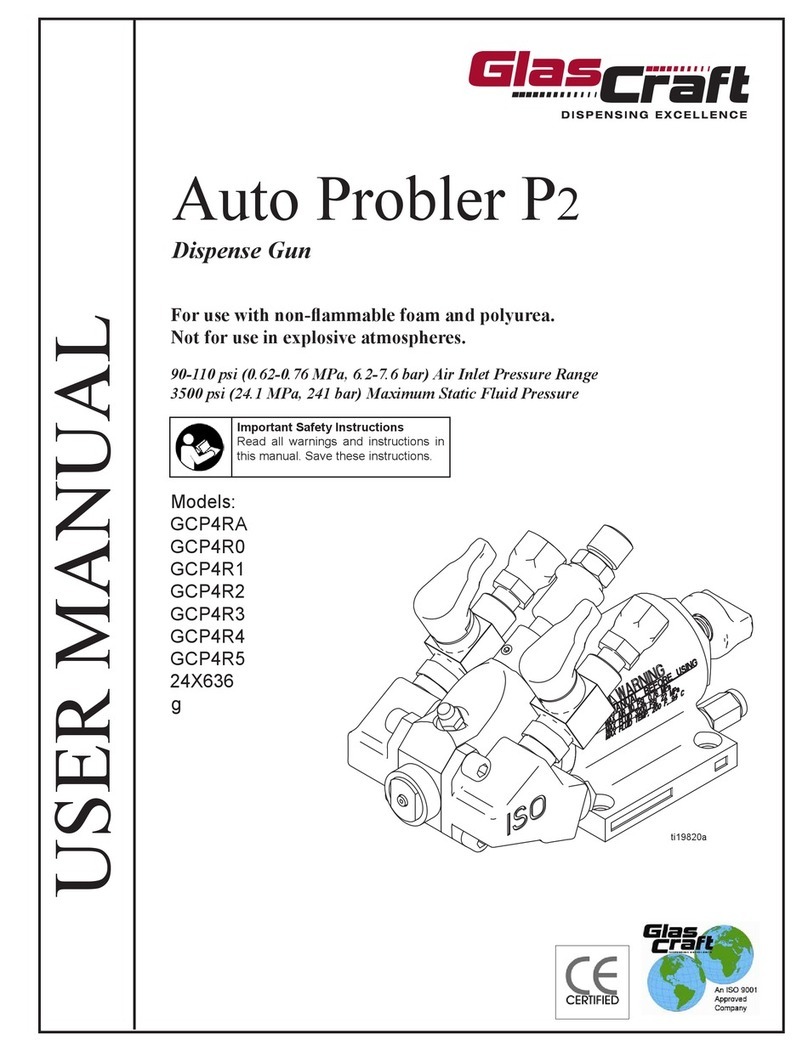
Glas Craft
Glas Craft Auto Probler P2 User manual
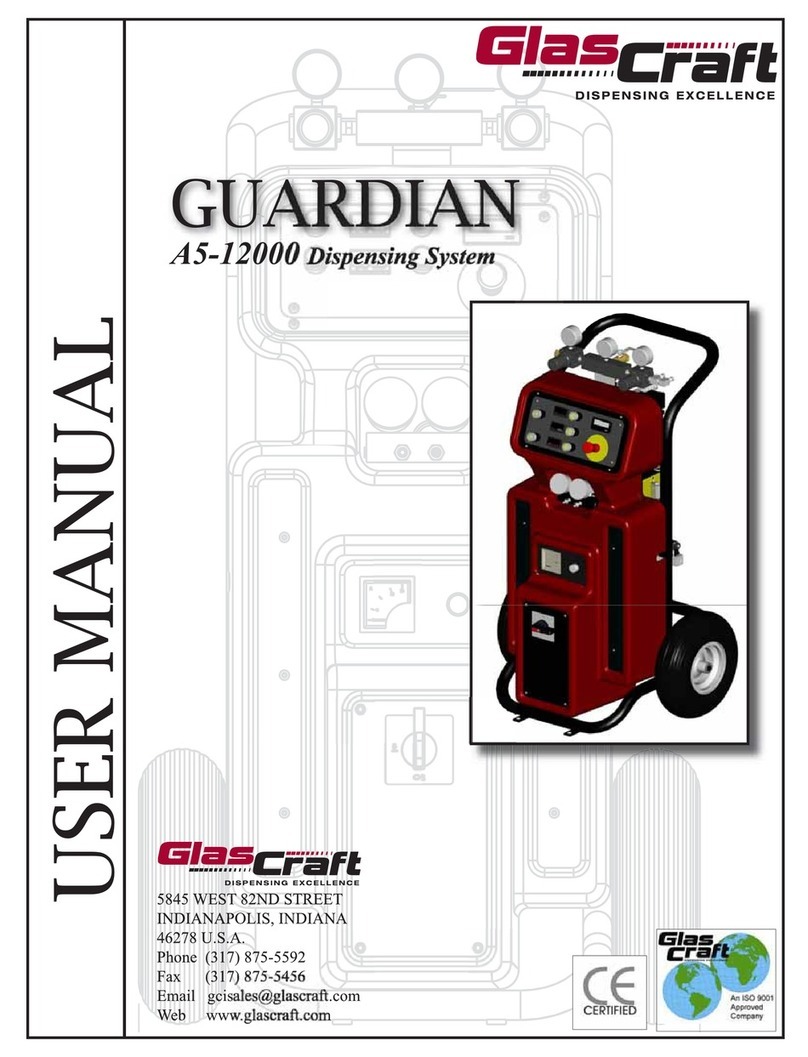
Glas Craft
Glas Craft GUARDIAN User manual
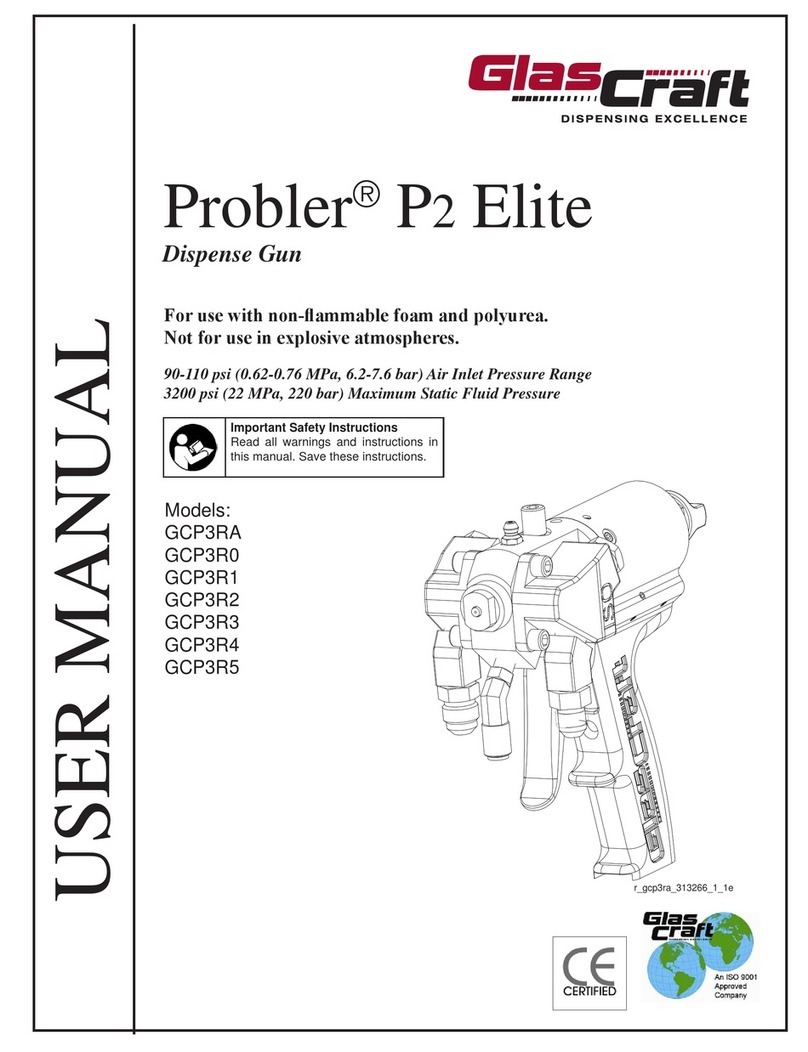
Glas Craft
Glas Craft GCP3RA User manual
